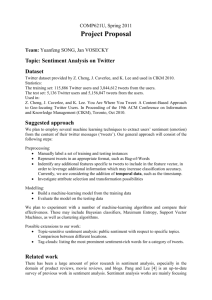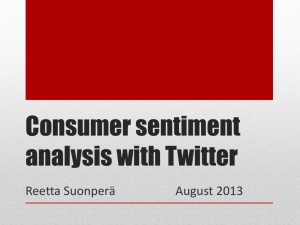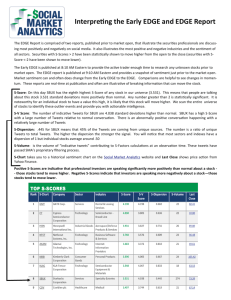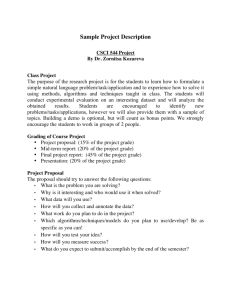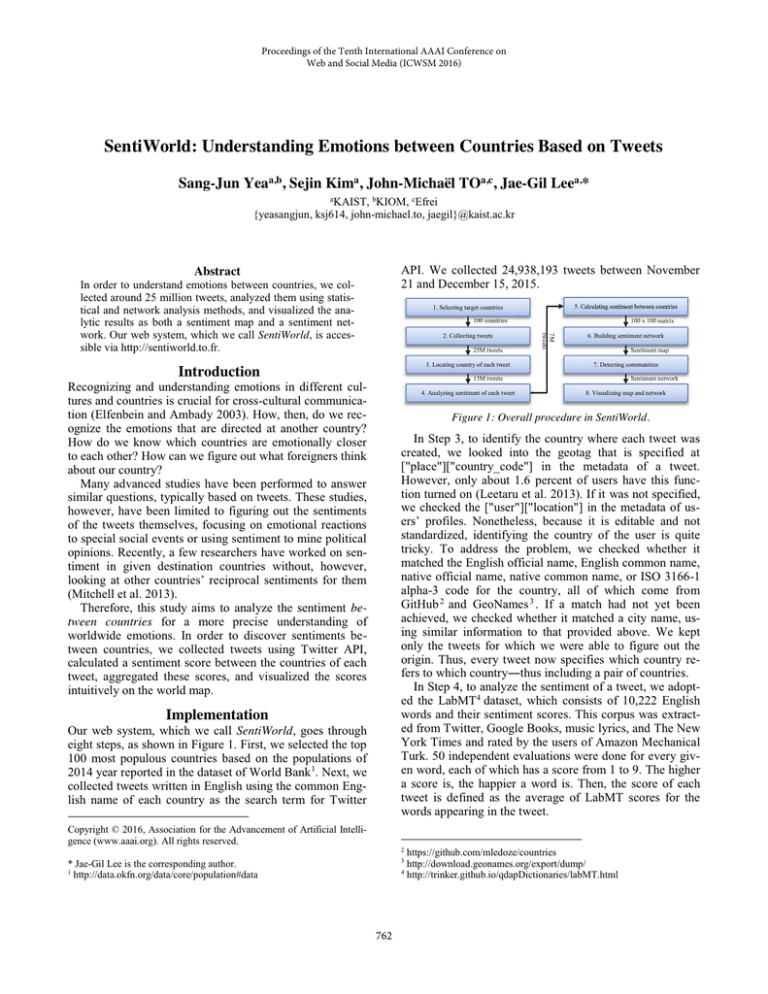
Proceedings of the Tenth International AAAI Conference on
Web and Social Media (ICWSM 2016)
SentiWorld: Understanding Emotions between Countries Based on Tweets
Sang-Jun Yeaa,b, Sejin Kima, John-Michaël TOa,c, Jae-Gil Leea,*
aKAIST, bKIOM, cEfrei
{yeasangjun, ksj614, john-michael.to, jaegil}@kaist.ac.kr
API. We collected 24,938,193 tweets between November
21 and December 15, 2015.
Abstract
In order to understand emotions between countries, we collected around 25 million tweets, analyzed them using statistical and network analysis methods, and visualized the analytic results as both a sentiment map and a sentiment network. Our web system, which we call SentiWorld, is accessible via http://sentiworld.to.fr.
5.
1. Selecting target countries
100 countries
counttrie
coun
tries
i s
225M
5M tw
ttweets
eets
t
3. Locating country of each tweet
Introduction
13M twee
tweets
ts
Recognizing and understanding emotions in different cultures and countries is crucial for cross-cultural communication (Elfenbein and Ambady 2003). How, then, do we recognize the emotions that are directed at another country?
How do we know which countries are emotionally closer
to each other? How can we figure out what foreigners think
about our country?
Many advanced studies have been performed to answer
similar questions, typically based on tweets. These studies,
however, have been limited to figuring out the sentiments
of the tweets themselves, focusing on emotional reactions
to special social events or using sentiment to mine political
opinions. Recently, a few researchers have worked on sentiment in given destination countries without, however,
looking at other countries’ reciprocal sentiments for them
(Mitchell et al. 2013).
Therefore, this study aims to analyze the sentiment between countries for a more precise understanding of
worldwide emotions. In order to discover sentiments between countries, we collected tweets using Twitter API,
calculated a sentiment score between the countries of each
tweet, aggregated these scores, and visualized the scores
intuitively on the world map.
4. Analyzing sentiment of each tweet
100 x 100
100 matrix
mattrix
i
7M
tweets
2. Collecting tweets
Sentiment
S
Senti
timentt mapp
7. Detecting communities
6. Building sentiment network
Sentiment
S
Senti
entiment
iment networ
ne
network
tworkk
8. Visualizing map and network
Figure 1: Overall procedure in SentiWorld.
In Step 3, to identify the country where each tweet was
created, we looked into the geotag that is specified at
["place"]["country_code"] in the metadata of a tweet.
However, only about 1.6 percent of users have this function turned on (Leetaru et al. 2013). If it was not specified,
we checked the ["user"]["location"] in the metadata of users’ profiles. Nonetheless, because it is editable and not
standardized, identifying the country of the user is quite
tricky. To address the problem, we checked whether it
matched the English official name, English common name,
native official name, native common name, or ISO 3166-1
alpha-3 code for the country, all of which come from
GitHub 2 and GeoNames 3 . If a match had not yet been
achieved, we checked whether it matched a city name, using similar information to that provided above. We kept
only the tweets for which we were able to figure out the
origin. Thus, every tweet now specifies which country refers to which country―thus including a pair of countries.
In Step 4, to analyze the sentiment of a tweet, we adopted the LabMT4 dataset, which consists of 10,222 English
words and their sentiment scores. This corpus was extracted from Twitter, Google Books, music lyrics, and The New
York Times and rated by the users of Amazon Mechanical
Turk. 50 independent evaluations were done for every given word, each of which has a score from 1 to 9. The higher
a score is, the happier a word is. Then, the score of each
tweet is defined as the average of LabMT scores for the
words appearing in the tweet.
Implementation
Our web system, which we call SentiWorld, goes through
eight steps, as shown in Figure 1. First, we selected the top
100 most populous countries based on the populations of
2014 year reported in the dataset of World Bank 1. Next, we
collected tweets written in English using the common English name of each country as the search term for Twitter
Copyright © 2016, Association for the Advancement of Artificial Intelligence (www.aaai.org). All rights reserved.
2
https://github.com/mledoze/countries
http://download.geonames.org/export/dump/
4
http://trinker.github.io/qdapDictionaries/labMT.html
3
* Jae-Gil Lee is the corresponding author.
1
http://data.okfn.org/data/core/population#data
762
In Step 5, to calculate the sentiment score between countries, we used the country identified in Step 3 as the source
country and the query country from Step 2 as the destination country. Then, the country-wise score is defined as the
average of the scores of relevant tweets. We discovered
that the number of tweets between countries follows the
power law distribution5. In addition, we provided a word
cloud wherein the word sizes were proportional to the term
frequency-inverse document frequency (TF-IDF).
In Step 6, we built a directed and weighted sentiment
network, which is composed of countries as nodes and of
the sentiment score as an edge weight. In Step 7, we adopted the Louvain and Infomap methods to detect communities. In order to apply Louvain, we transformed it into an
undirected and unweighted network by keeping an edge
between two countries if both directional sentiment scores
were built from more than 100 tweets and if the difference
between them was smaller than 0.3. Prior to running Infomap, in order to get a similar number of communities, we
removed the edges built from less than 2500 tweets. Those
network analysis results are visualized using D3.js6.
ty in Infomap mainly represents a center country and the
other countries that the center country thinks about similarly; a community in Louvain mainly represents a group of
countries that think similarly to each other.
Figure 3: Sentiment network of communities.
Discussion and Conclusion
France has “Paris,” “right,” and “attack” as big words in
the word cloud of its in-coming sentiment map. The big
word “right” appeared mostly from the developed countries that participated in the United Nations Climate
Change Conference (UNCCC) held in Paris, whereas the
big word “attack” came mostly from the Arabic countries
which have continued to focus on the terrorist attack in
Paris rather than the UNCCC. In order to drill down for the
issues between countries, we compared the in-coming sentiments for France and other developed countries. Suppose
that G1 = {France}, G2 = {USA, United Kingdom, Germany, Netherland}, G3 = {Iran, Iraq, Syria, Yemen}, and
(A, B) denotes the sentiment score from A to B. It turned
out that (G2, G1) – (G3, G1) = 0.50 and (G2, G2) – (G3,
G2) = 0.24. This observation implies that developed countries (G2) and Arabic countries (G3) have greater variances
in the way they think about France than in their thoughts
about other countries (e.g., Germany), possibly owing to
the terrorist attack and the UNCCC in Paris.
As the future work, we plan to support time-evolving
analysis and variable length of temporal windows.
System Demonstration
Our web system is accessible via http://sentiworld.to.fr
using Firefox or Chrome browsers.
(1) As shown in Figure 2, the sentiment map with chord
diagrams shows the results of Step 6 in a dynamic way. It
includes in-coming and out-going maps in which the color
of an arc represents the sentiment score and the width of an
arc’s line shows the number of tweets between countries.
The in-coming map shows how other countries think about
a given country in terms of sentiment scores, and the outgoing map shows how a given country thinks about other
countries. In addition, the actual score and count show up
in a tooltip box when the mouse cursor rolls over the point
of a country. In this way, users can estimate the reliability
of the sentiment score by the count.
Acknowledgements
This research was partly supported by the maximum utilization of
knowledge about herbal resource research program funded by the
KIOM (Korea Institute of Oriental Medicine) (K16404) and the
MOLIT (The Ministry of Land, Infrastructure and Transport),
Korea, under the national spatial information research program
supervised by the KAIA (Korea Agency for Infrastructure Technology Advancement) (15NSIP-B081011-02).
Figure 2: In-coming sentiment map for France.
References
(2) As shown in Figure 3, the sentiment network of
communities shows the communities detected by the Louvain and Infomap methods in Step 7. The colors of the
nodes and intra-community edges indicate the communities
to which the countries belong. In order to show each community clearly, we removed inter-community edges, owing
to the high density of the sentiments network. A communi5
6
Elfenbein, H. A. and Ambady, N. 2003. Universals and cultural
differences in recognizing emotions. Current Directions in Psychological Science, 12(5): 159‒164.
Leetaru, K., Wang, S., Cao, G., Padmanabhan, A., and Shook, E.
2013. Mapping the global Twitter heartbeat: The geography of
Twitter. First Monday, 18(5).
Mitchell, L., Frank, M. R., Harris, K. D., Dodds, P. S., and
Danforth, C. M. 2013. The geography of happiness: Connecting
twitter sentiment and expression, demographics, and objective
characteristics of place. PLoS ONE, 8(5): e64417.
http://sentiworld.to.fr/statistical_analysis.html
http://d3js.org/
763



